 Every so often we get one of these anime episode that’s so sublime, so perfect, that it frustrates me as a writer. Because really, what could I possibly do in scribbling a few paragraphs about something so lovely except cheapen the experience? Not only that, if I straight-out say what I thought, it sounds like I’m gushing over it – because in effect, I am. It’s a lose-lose situation, but what can you do? I’d be lying if I said it wasn’t a problem I wish I had to deal with more often.
Every so often we get one of these anime episode that’s so sublime, so perfect, that it frustrates me as a writer. Because really, what could I possibly do in scribbling a few paragraphs about something so lovely except cheapen the experience? Not only that, if I straight-out say what I thought, it sounds like I’m gushing over it – because in effect, I am. It’s a lose-lose situation, but what can you do? I’d be lying if I said it wasn’t a problem I wish I had to deal with more often.
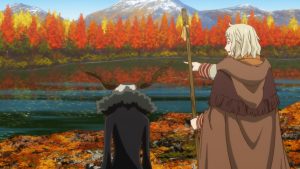 I knew when I saw those few minutes of footage of Mahoutsukai no Yome way back in July of 2016 (at Anime Expo) that there was potential for some visual magic here. But at this point I’m starting to consider that this show might be the most beautifully drawn and animated TV anime since Hyouka – indeed, I’d put it in that tiny sub-category which holds that series, Seirei no Moribito and frankly, not a whole lot else. It’s not simply about detailed backgrounds and fluid animation – though those obviously help. It’s also about artistry and imagination, a sense of the soul of the animators and artists coming through. Moribito had that, Hyouka had it – and so does The Ancient Magus’ Bride.
I knew when I saw those few minutes of footage of Mahoutsukai no Yome way back in July of 2016 (at Anime Expo) that there was potential for some visual magic here. But at this point I’m starting to consider that this show might be the most beautifully drawn and animated TV anime since Hyouka – indeed, I’d put it in that tiny sub-category which holds that series, Seirei no Moribito and frankly, not a whole lot else. It’s not simply about detailed backgrounds and fluid animation – though those obviously help. It’s also about artistry and imagination, a sense of the soul of the animators and artists coming through. Moribito had that, Hyouka had it – and so does The Ancient Magus’ Bride.
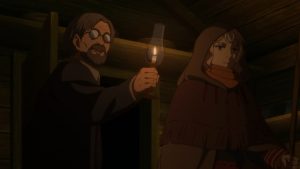 In a vacuum, that kind of visual beauty can take you only so far – pretty far, but only so far. But in episodes like this one (and I’d argue most profoundly in this one) Mahoutsukai shows that it has the narrative beauty to go along with it. It can be awkward at times, but this series has a magical quality of transporting you inside the moment, and of making you feel what the characters feel on a visceral level. There’s a pull that the ancient mysteries assert on humans – we all feel it, whether we want to admit it or not. We remember, deep down, the music of wind and water and earth, before there were words. And part of us always longs to return to that feeling of awe, that sense of elemental and inscrutable power that surrounds us at all times.
In a vacuum, that kind of visual beauty can take you only so far – pretty far, but only so far. But in episodes like this one (and I’d argue most profoundly in this one) Mahoutsukai shows that it has the narrative beauty to go along with it. It can be awkward at times, but this series has a magical quality of transporting you inside the moment, and of making you feel what the characters feel on a visceral level. There’s a pull that the ancient mysteries assert on humans – we all feel it, whether we want to admit it or not. We remember, deep down, the music of wind and water and earth, before there were words. And part of us always longs to return to that feeling of awe, that sense of elemental and inscrutable power that surrounds us at all times.
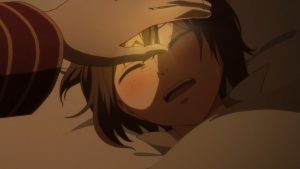 That’s part of the magic and beauty of this series, no question – that, and the ethereally gorgeous landscapes it transports us to through its incredibly gifted creative staff. But the human story is equally compelling, even if the ones at the heart of it aren’t all human. And as Lindel continues to tell Chise (and us) Elias’ story, it becomes increasingly clear that the Thorn Mage is not human himself. “A quick learner,” Lindel tells us, but “always seeming to be looking in from the outside.” Elias is the shadow the child with the sight (red-haired, it should be noted) sees on the wall in the candlelight. He’s the fury which unleashes itself on frightened villagers after they wound Lindel with a rock. Elias seems as alien to us as any of the faerie folk we’ve met on this journey.
That’s part of the magic and beauty of this series, no question – that, and the ethereally gorgeous landscapes it transports us to through its incredibly gifted creative staff. But the human story is equally compelling, even if the ones at the heart of it aren’t all human. And as Lindel continues to tell Chise (and us) Elias’ story, it becomes increasingly clear that the Thorn Mage is not human himself. “A quick learner,” Lindel tells us, but “always seeming to be looking in from the outside.” Elias is the shadow the child with the sight (red-haired, it should be noted) sees on the wall in the candlelight. He’s the fury which unleashes itself on frightened villagers after they wound Lindel with a rock. Elias seems as alien to us as any of the faerie folk we’ve met on this journey.
 There is a sense that Elias’ privacy is being invaded by having Lindel tell Chise his story – she certainly feels that herself. Even Lindel, powerful mage that he is, was afraid when Elias told him that he was certain he’d eaten humans before – though Lindel was composed enough not to show it. Lindel clearly feels that these are things Chise must hear – and that Elias may never be ready to share them himself – though it’s not, I think, by way of warning to her. In Lindel’s eyes both Elias and Chise are indeed children, and he’s trying to raise them as best he can – to shove them towards the truth when they’re foundering on their own.
There is a sense that Elias’ privacy is being invaded by having Lindel tell Chise his story – she certainly feels that herself. Even Lindel, powerful mage that he is, was afraid when Elias told him that he was certain he’d eaten humans before – though Lindel was composed enough not to show it. Lindel clearly feels that these are things Chise must hear – and that Elias may never be ready to share them himself – though it’s not, I think, by way of warning to her. In Lindel’s eyes both Elias and Chise are indeed children, and he’s trying to raise them as best he can – to shove them towards the truth when they’re foundering on their own.
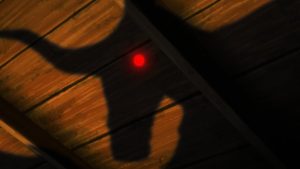 After a short but wonderful episode where the pack of dragon bozu knock Chise into the water (again), and she meets what appears to be a water dragon (a scene so beautiful one imagines it must surely be the highlight of the episode) Chise sets about making her wand at last. Her red hair will be the essence of it, Nevin’s branch the heart of it, but now Chise must carve the handle – and Lindel shows her a variety of larges branches to choose from. Each of the source trees is powerful in some way, connected to the mysteries of the ancients. And Lindel advises Chise to talk to herself as she carves – something not so easy for a child with so little sense of self.
After a short but wonderful episode where the pack of dragon bozu knock Chise into the water (again), and she meets what appears to be a water dragon (a scene so beautiful one imagines it must surely be the highlight of the episode) Chise sets about making her wand at last. Her red hair will be the essence of it, Nevin’s branch the heart of it, but now Chise must carve the handle – and Lindel shows her a variety of larges branches to choose from. Each of the source trees is powerful in some way, connected to the mysteries of the ancients. And Lindel advises Chise to talk to herself as she carves – something not so easy for a child with so little sense of self.
 As magnificent as all that is, the climax of the episode truly raises the bar – as Lindel reveals the true nature of his magic and his true name, “Echos”. His spells are songs, and in the land blessed by elves they carry great power. I’d be hard-pressed to think of a more perfectly-executed scene in anime this year – “beautiful” doesn’t even begin to do it justice. But there’s a larger story being told here, as Lindel’s magic opens a gateway through a water mirror to where Elias gazes silently into the night through his window. Chise’s first thought when seeing this beauty was that she wished Elias could see it too, and in some small way, thanks to the power of Lindel’s magic and her own desire, he does.
As magnificent as all that is, the climax of the episode truly raises the bar – as Lindel reveals the true nature of his magic and his true name, “Echos”. His spells are songs, and in the land blessed by elves they carry great power. I’d be hard-pressed to think of a more perfectly-executed scene in anime this year – “beautiful” doesn’t even begin to do it justice. But there’s a larger story being told here, as Lindel’s magic opens a gateway through a water mirror to where Elias gazes silently into the night through his window. Chise’s first thought when seeing this beauty was that she wished Elias could see it too, and in some small way, thanks to the power of Lindel’s magic and her own desire, he does.
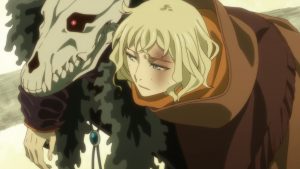 Nothing is simple when it comes to Chise and (especially) Elias, that’s for certain – even in the midst of almost unbearable beauty the body of a sparrow reminds us of that. But when Elias tells Chise that his home feels cold without her, he reveals something of himself in the process. And Chise’s promise to share her own story now that she’s heard so much of Elias’ is a measure of the trust she has in him, in the face of so many warnings and of her own painful interactions with others. If magic is anything, it’s that these two damaged spirits could be connected across a great gulf of the soul and half the Earth.
Nothing is simple when it comes to Chise and (especially) Elias, that’s for certain – even in the midst of almost unbearable beauty the body of a sparrow reminds us of that. But when Elias tells Chise that his home feels cold without her, he reveals something of himself in the process. And Chise’s promise to share her own story now that she’s heard so much of Elias’ is a measure of the trust she has in him, in the face of so many warnings and of her own painful interactions with others. If magic is anything, it’s that these two damaged spirits could be connected across a great gulf of the soul and half the Earth.





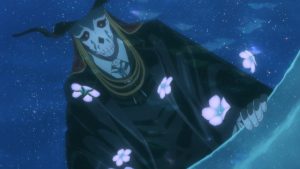
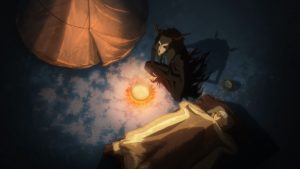

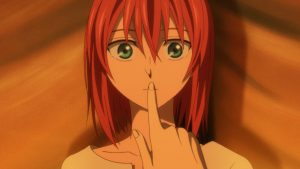
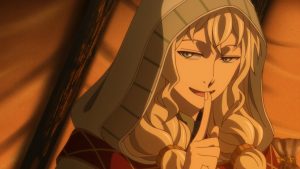
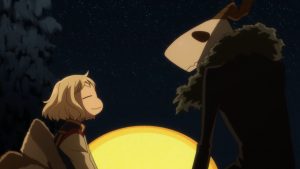
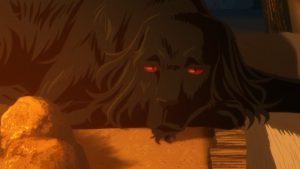

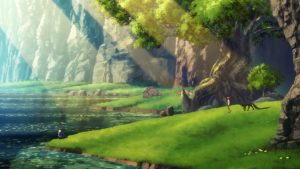
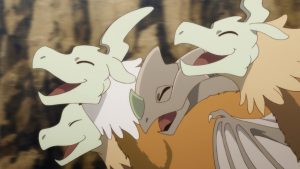
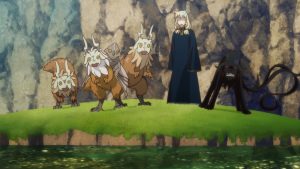
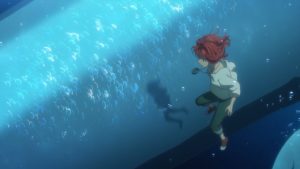

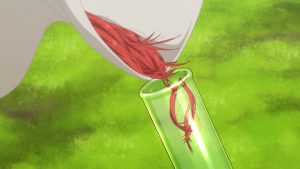
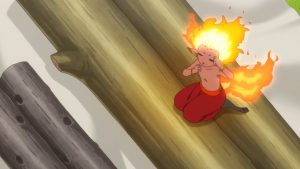
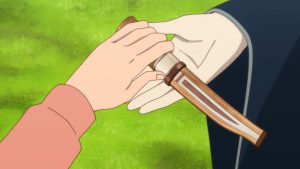
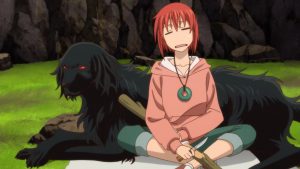


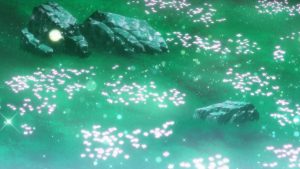
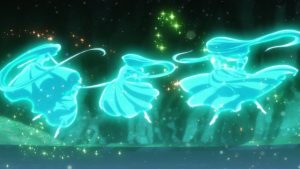

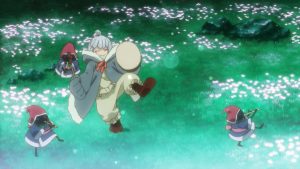
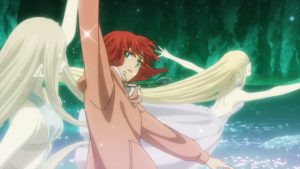
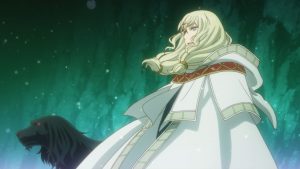

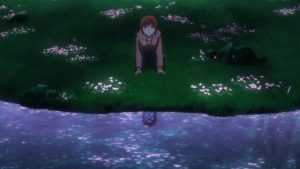
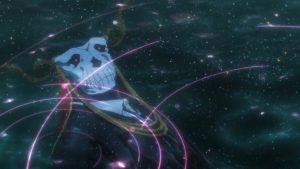
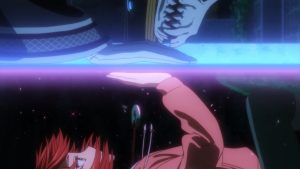
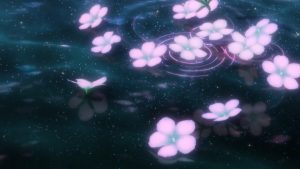
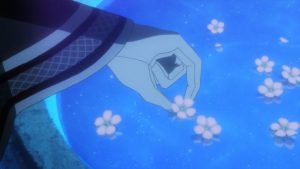
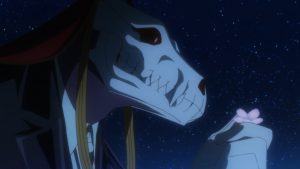
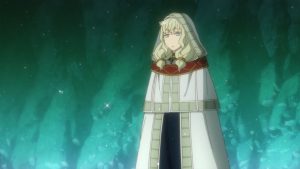
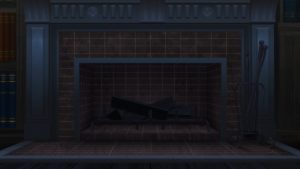
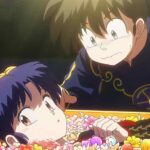
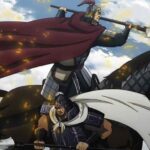
G2
December 17, 2017 at 10:13 amIt is a beautiful episode indeed. Thank you for your review as well written as always
Molly
December 17, 2017 at 12:57 pmGiven that I binge read the manga quite some time ago, I forgot some of these lovely moments like Lindel’s singing or Chise’s dance with the elves. This is one of the series* where I prefer these episodes to those with Cartaphilus and Renfred.
*This is not the case with Natsume Yuunjinchou but than again Mahoutsukai has a much darker tone than Natsume
elianthos
December 17, 2017 at 2:55 pmWhen this blogger ascends to lyrical language we know this episode is Good Stuff 8D.
Not much to add on the episode content insight after the gushing fountain of Enzo Eloquence… hence some little tidbits follow:
– soredemo sekai wa utsukushi * sorry not sorry *
– Lindel’s pupil are shaped a bit like a dragon’s. Is he partly non-human too?
– the visual flourishes (the twinkles and the bokeh effect) for the whole spell song sequence achieved a lot with very little. Clever.
– the water mirror moment was really lovely – and lovingly – adapted.
– talking of water Chise’s fall vibe and attitude was definitely better this time.
– steampunk bird corpses and spent logs of aptly ambivalent symbolism!
– NamiDai’s singing voice is 2x the blessing. Oh LinDaddy <3
Guardian Enzo
December 17, 2017 at 5:46 pmI assumed that was someone else actually singing… Do we know?
Yes, the visual flourishes are the key – that’s what made Hyouka not just great visually, but historically great. It’s artistry and craftsmanship both. I did love Soredemo Sekai’s visuals but I can’t put them in this class. Maybe the first season of Mushishi (for it’s time) and some of the early Natsume when it was at Brain’s Base.
elianthos
December 18, 2017 at 3:30 am@Enzo: 99% chances it’s his voice. Have you forgotten Hisoka can sing? ^^ https://www.youtube.com/watch?v=8MkY26zMfZY I’d see no reason to switch to someone else when he can handle the singing pretty decently himself. For all we know maybe his ability was one of the reasons they cast him as Lindel in TAMB. It sure doesn’t hurt…
Ah my Soredemo nod was actually about Rahab’s “welcome to the world'”to Elias. And a bit about the shared(?) ‘mismatched and unlikely relationship that shouldn’t work as well as it does yet here we are’ in hindsight too. Pierrot did what they could with the budget. It doesn’t look bad but it averages just around pleasantly serviceable (memorable points for the two mains and Grandma’s Farewell Rain song. Now THAT was a song).
If we are talking visual flourishes I agree about some the first season Mushishi epis (the white episode, the golden yellow episode, the purple palette one were amongst my favourite visual treats) . Personally I find most of Gankutsuou use of patterns and flat textures to still be glorious (YMMV on the 3D CG bits instead :°D), as well as Mononoke&Bakeneko’s Medicine Seller extraordinarily texturally rich visuals ( almost any single frame is worth hanging on the walls really. What a feast). And then Moribito of course. They all managed to keep both artistry quality and consistency throughout their run.
TAMB I’d put a step below because is not as consistent but when it’s on it’s ON.
Bel
December 18, 2017 at 5:40 amThe ending credit says the insert song is sung by 竹中大地 (Takenaka Daichi). The singer himself tweeted about it here. I commend the anime staff for finding a singer whose voice bears some resemblance to Namikawa Daisuke.
elianthos
December 18, 2017 at 6:45 am@Bel: indeed. Thanks for the info 😀
Guardian Enzo
December 18, 2017 at 8:26 amThanks for that and yeah, it kind of does sound like him.
Terrance Crow
December 17, 2017 at 3:36 pmThanks for a review that was almost as moving as the episode itself! I can see that the series really resonates with you, so your mention of Hyouka piqued my interest. You obviously have good taste in anime, so I went to iTunes and bought the original Japanese version. I just started watching it, and I’m not even 10 minutes in and I can see what you meant. So not only thanks for this review, but thanks for pointing out another great series at the same time!
Guardian Enzo
December 17, 2017 at 5:47 pmThank you Terrance – very kind. What I will say about Hyouka is this – don’t judge it by the first couple of episodes. Yeah it’s gorgeous from the gun, but IMHO the story takes a few episodes to really catch fire.
Dop
December 18, 2017 at 4:28 pmThe musical sequence is one of those things which shows how a good anime adaptation can take the manga material and uplift it to a higher plane. It was quite simply magical.